light Acura TL 2000 3.2 Owner's Manual
[x] Cancel search | Manufacturer: ACURA, Model Year: 2000, Model line: TL, Model: Acura TL 2000Pages: 311, PDF Size: 3.05 MB
Page 6 of 311
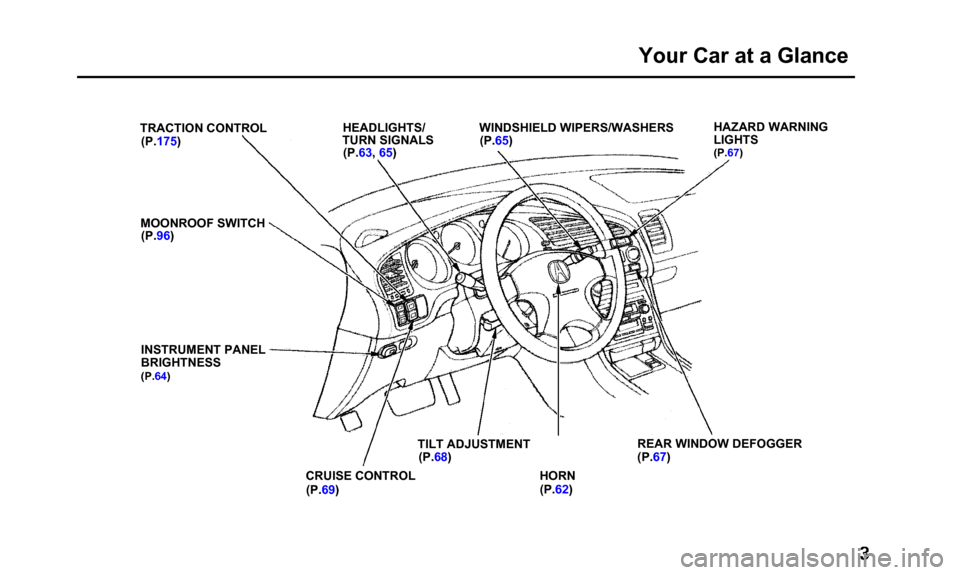
Your Car at a Glance
TRACTION CONTROL(P.175)
MOONROOF SWITCH (P.96)
INSTRUMENT PANEL
BRIGHTNESS
(P.64)
HEADLIGHTS/
TURN SIGNALS (P.63, 65) WINDSHIELD WIPERS/WASHERS
(P.65) HAZARD WARNING
LIGHTS
(P.67)
CRUISE CONTROL
(P.69) HORN
(P.62)
TILT ADJUSTMENT
(P.68) REAR WINDOW DEFOGGER
(P.67)
Page 8 of 311
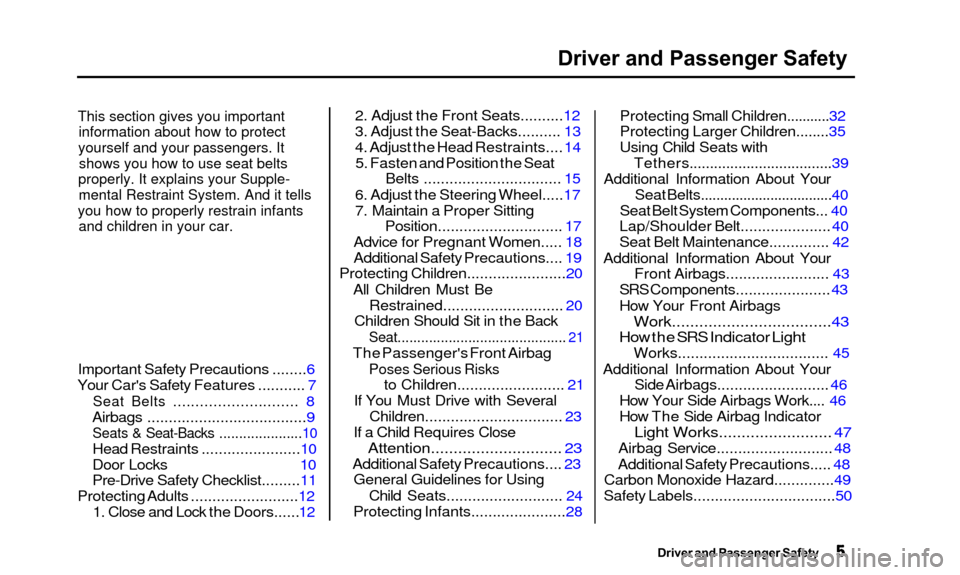
Driver and Passenger Safety
This section gives you importantinformation about how to protect
yourself and your passengers. It shows you how to use seat belts
properly. It explains your Supple- mental Restraint System. And it tells
you how to properly restrain infants and children in your car.
Important Safety Precautions ........6
Your Car's Safety Features ........... 7
Seat Belts ............................ 8
Airbags .....................................9
Seats & Seat-Backs .....................10
Head Restraints .......................10
Door Locks 10
Pre-Drive Safety Checklist.........11
Protecting Adults .........................12 1. Close and Lock the Doors...... 122. Adjust the Front Seats..........12
3. Adjust the Seat-Backs.......... 13
4. Adjust the Head Restraints.... 14
5. Fasten and Position the Seat Belts ................................ 15
6. Adjust the Steering Wheel..... 17
7. Maintain a Proper Sitting Position............................. 17
Advice for Pregnant Women..... 18
Additional Safety Precautions.... 19
Protecting Children.......................20
All Children Must Be Restrained............................ 20
Children Should Sit in the Back
Seat........................................... 21
The Passenger's Front Airbag
Poses Serious Risks
to Children......................... 21
If You Must Drive with Several Children................................ 23
If a Child Requires Close
Attention............................. 23
Additional Safety Precautions.... 23 General Guidelines for Using
Child Seats........................... 24
Protecting Infants......................28 Protecting Small Children...........32
Protecting Larger Children........35
Using Child Seats with
Tethers...................................39
Additional Information About Your Seat Belts..................................40
Seat Belt System Components... 40
Lap/Shoulder Belt..................... 40
Seat Belt Maintenance.............. 42
Additional Information About Your Front Airbags........................ 43
SRS Components...................... 43
How Your Front Airbags
Work...................................43
How the SRS Indicator Light
Works................................... 45
Additional Information About Your Side Airbags.......................... 46
How Your Side Airbags Work.... 46
How The Side Airbag Indicator
Light Works......................... 47
Airbag Service........................... 48
Additional Safety Precautions..... 48
Carbon Monoxide Hazard..............49
Safety Labels.................................50
Driver and Passenger Safety
Page 11 of 311
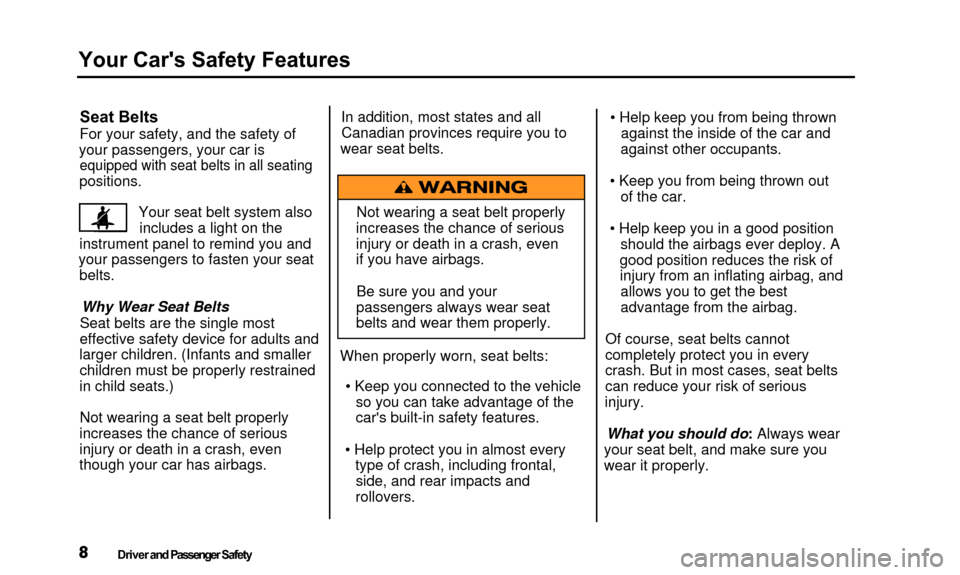
Your Car's Safety Features
Seat Belts
For your safety, and the safety of
your passengers, your car is
equipped with seat belts in all seating
positions.
Your seat belt system alsoincludes a light on the
instrument panel to remind you and
your passengers to fasten your seat belts.
Why Wear Seat Belts
Seat belts are the single most
effective safety device for adults and
larger children. (Infants and smaller children must be properly restrained
in child seats.)
Not wearing a seat belt properly
increases the chance of serious
injury or death in a crash, even
though your car has airbags. In addition, most states and all
Canadian provinces require you to
wear seat belts.
Not wearing a seat belt properly
increases the chance of serious
injury or death in a crash, even
if you have airbags.
Be sure you and your
passengers always wear seat
belts and wear them properly.
When properly worn, seat belts: • Keep you connected to the vehicle so you can take advantage of the
car's built-in safety features.
• Help protect you in almost every type of crash, including frontal,side, and rear impacts and
rollovers. • Help keep you from being thrown
against the inside of the car and
against other occupants.
• Keep you from being thrown out of the car.
• Help keep you in a good position should the airbags ever deploy. A
good position reduces the risk of injury from an inflating airbag, andallows you to get the best
advantage from the airbag.
Of course, seat belts cannot
completely protect you in every
crash. But in most cases, seat belts
can reduce your risk of serious
injury.
What you should do: Always wear
your seat belt, and make sure you
wear it properly.
Driver and Passenger Safety
Page 15 of 311
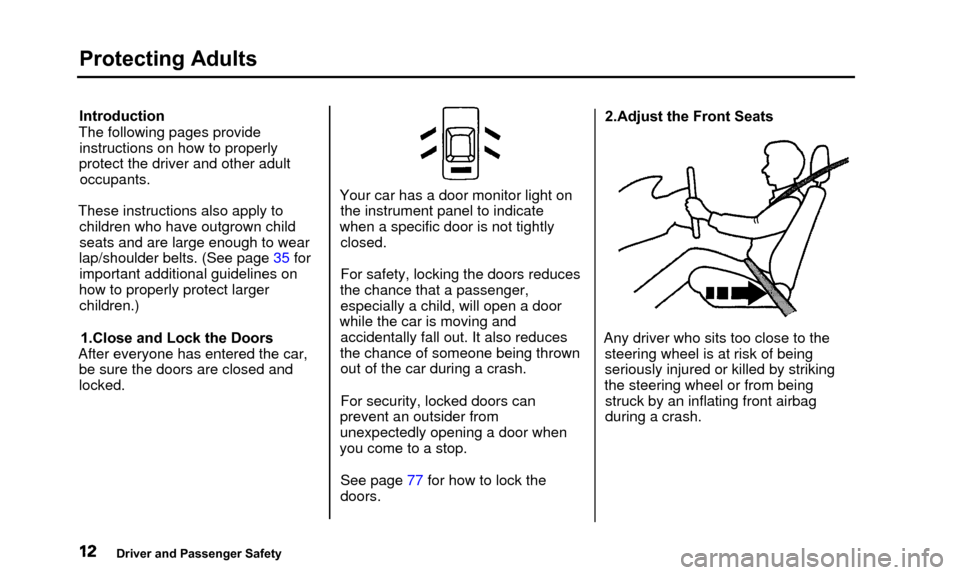
Protecting Adults
Introduction
The following pages provide instructions on how to properly
protect the driver and other adult occupants.
These instructions also apply to children who have outgrown child
seats and are large enough to wear
lap/shoulder belts. (See page 35 for important additional guidelines on
how to properly protect larger children.)
1.Close and Lock the Doors
After everyone has entered the car, be sure the doors are closed and
locked. Your car has a door monitor light on
the instrument panel to indicate
when a specific door is not tightly closed.
For safety, locking the doors reduces
the chance that a passenger, especially a child, will open a door
while the car is moving and accidentally fall out. It also reduces
the chance of someone being thrown out of the car during a crash.
For security, locked doors can
prevent an outsider from
unexpectedly opening a door when
you come to a stop.
See page 77 for how to lock the
doors. 2.Adjust the Front Seats
Any driver who sits too close to the steering wheel is at risk of being
seriously injured or killed by striking
the steering wheel or from being struck by an inflating front airbag
during a crash.
Driver and Passenger Safety
Page 43 of 311
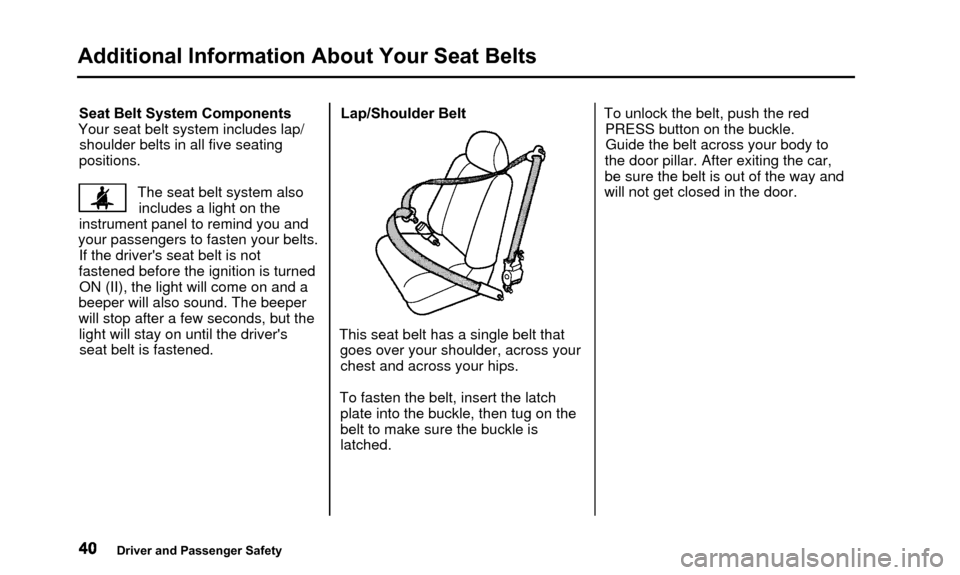
Additional Information About Your Seat Belts
Seat Belt System Components
Your seat belt system includes lap/ shoulder belts in all five seating
positions.
The seat belt system alsoincludes a light on the
instrument panel to remind you and
your passengers to fasten your belts. If the driver's seat belt is not
fastened before the ignition is turned ON (II), the light will come on and a
beeper will also sound. The beeper
will stop after a few seconds, but the light will stay on until the driver'sseat belt is fastened. Lap/Shoulder Belt
This seat belt has a single belt that goes over your shoulder, across yourchest and across your hips.
To fasten the belt, insert the latch plate into the buckle, then tug on the
belt to make sure the buckle islatched. To unlock the belt, push the red
PRESS button on the buckle.Guide the belt across your body to
the door pillar. After exiting the car,
be sure the belt is out of the way and
will not get closed in the door.
Driver and Passenger Safety
Page 46 of 311
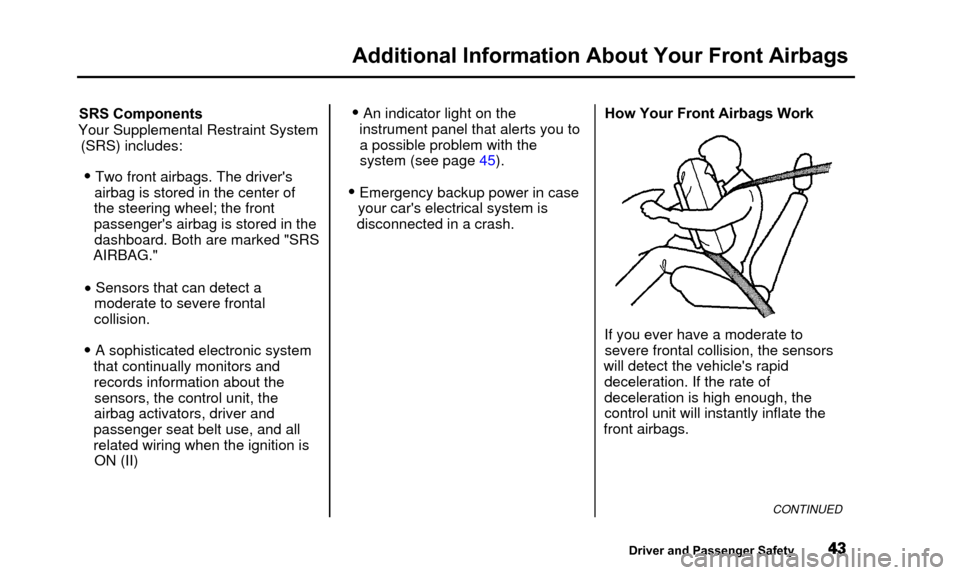
Additional Information About Your Front Airbags
SRS Components
Your Supplemental Restraint System (SRS) includes:
• Two front airbags. The driver's airbag is stored in the center of
the steering wheel; the front
passenger's airbag is stored in the dashboard. Both are marked "SRS
AIRBAG."
• Sensors that can detect a moderate to severe frontal
collision.
• A sophisticated electronic system that continually monitors andrecords information about thesensors, the control unit, the
airbag activators, driver and
passenger seat belt use, and all related wiring when the ignition is ON (II)
• An indicator light on theinstrument panel that alerts you to a possible problem with the
system (see page 45).
• Emergency backup power in case your car's electrical system is
disconnected in a crash. How Your Front Airbags Work
If you ever have a moderate to severe frontal collision, the sensors
will detect the vehicle's rapid deceleration. If the rate of
deceleration is high enough, the
control unit will instantly inflate the
front airbags.
CONTINUED
Driver and Passenger Safety
Page 48 of 311
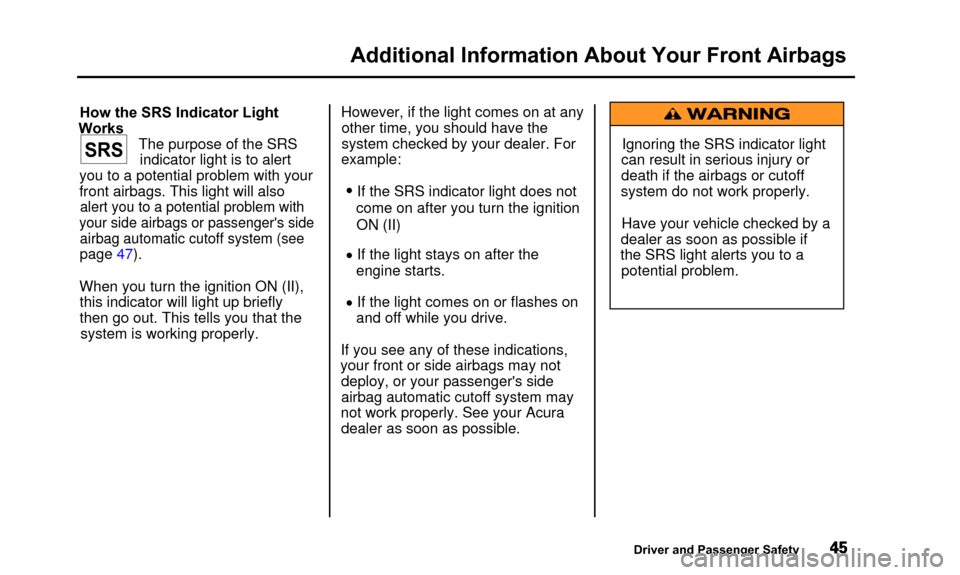
Additional Information About Your Front Airbags
How the SRS Indicator Light
Works The purpose of the SRSindicator light is to alert
you to a potential problem with your
front airbags. This light will also
alert you to a potential problem with
your side airbags or passenger's side airbag automatic cutoff system (see
page 47).
When you turn the ignition ON (II), this indicator will light up briefly
then go out. This tells you that the system is working properly. However, if the light comes on at any
other time, you should have the
system checked by your dealer. For
example:
• If the SRS indicator light does not
come on after you turn the ignitionON (II)
• If the light stays on after the engine starts.
• If the light comes on or flashes onand off while you drive.
If you see any of these indications,
your front or side airbags may not deploy, or your passenger's side
airbag automatic cutoff system may
not work properly. See your Acura dealer as soon as possible. Ignoring the SRS indicator light
can result in serious injury or
death if the airbags or cutoff
system do not work properly.
Have your vehicle checked by a
dealer as soon as possible if
the SRS light alerts you to a potential problem.
Driver and Passenger Safety
SRS
Page 50 of 311
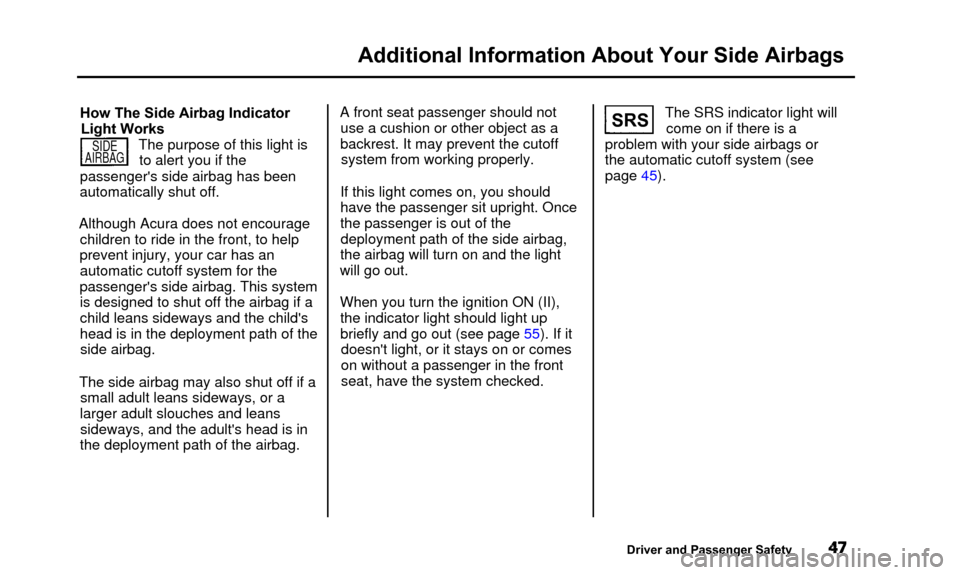
Additional Information About Your Side Airbags
How The Side Airbag IndicatorLight Works The purpose of this light isto alert you if the
SIDEAIRBAG
passenger's side airbag has been
automatically shut off.
Although Acura does not encourage children to ride in the front, to help
prevent injury, your car has an automatic cutoff system for the
passenger's side airbag. This system is designed to shut off the airbag if a
child leans sideways and the child's
head is in the deployment path of theside airbag.
The side airbag may also shut off if a small adult leans sideways, or a
larger adult slouches and leans sideways, and the adult's head is in
the deployment path of the airbag. A front seat passenger should not
use a cushion or other object as a
backrest. It may prevent the cutoff system from working properly.
If this light comes on, you should
have the passenger sit upright. Once
the passenger is out of the deployment path of the side airbag,
the airbag will turn on and the light
will go out.
When you turn the ignition ON (II), the indicator light should light up
briefly and go out (see page 55). If it doesn't light, or it stays on or comes
on without a passenger in the front
seat, have the system checked.
SRSThe SRS indicator light will come on if there is a
problem with your side airbags or
the automatic cutoff system (see
page 45).
Driver and Passenger Safety
Page 51 of 311
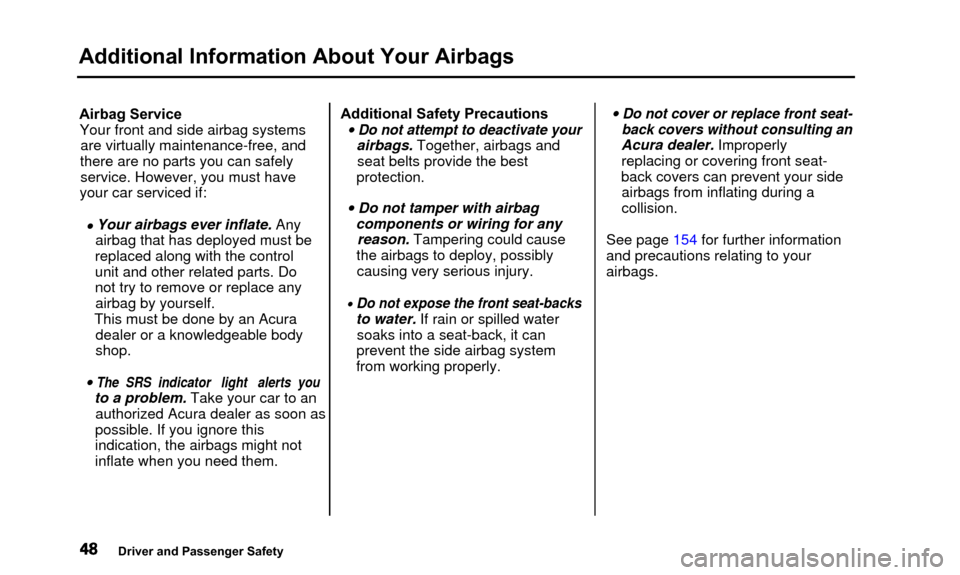
Additional Information About Your Airbags
Airbag ServiceYour front and side airbag systems are virtually maintenance-free, and
there are no parts you can safely service. However, you must have
your car serviced if:
• Your airbags ever inflate. Any airbag that has deployed must be
replaced along with the control
unit and other related parts. Do
not try to remove or replace any airbag by yourself.
This must be done by an Acura dealer or a knowledgeable body
shop.
• The SRS indicator light alerts you
to a problem. Take your car to anauthorized Acura dealer as soon as
possible. If you ignore this
indication, the airbags might not
inflate when you need them. Additional Safety Precautions
• Do not attempt to deactivate your
airbags. Together, airbags and
seat belts provide the best
protection.
• Do not tamper with airbag components or wiring for anyreason. Tampering could cause
the airbags to deploy, possibly causing very serious injury.
• Do not expose the front seat-backs
to water. If rain or spilled water soaks into a seat-back, it can
prevent the side airbag system
from working properly.
• Do not cover or replace front seat- back covers without consulting an
Acura dealer. Improperlyreplacing or covering front seat-
back covers can prevent your side airbags from inflating during a
collision.
See page 154 for further information
and precautions relating to your
airbags.
Driver and Passenger Safety
Page 54 of 311
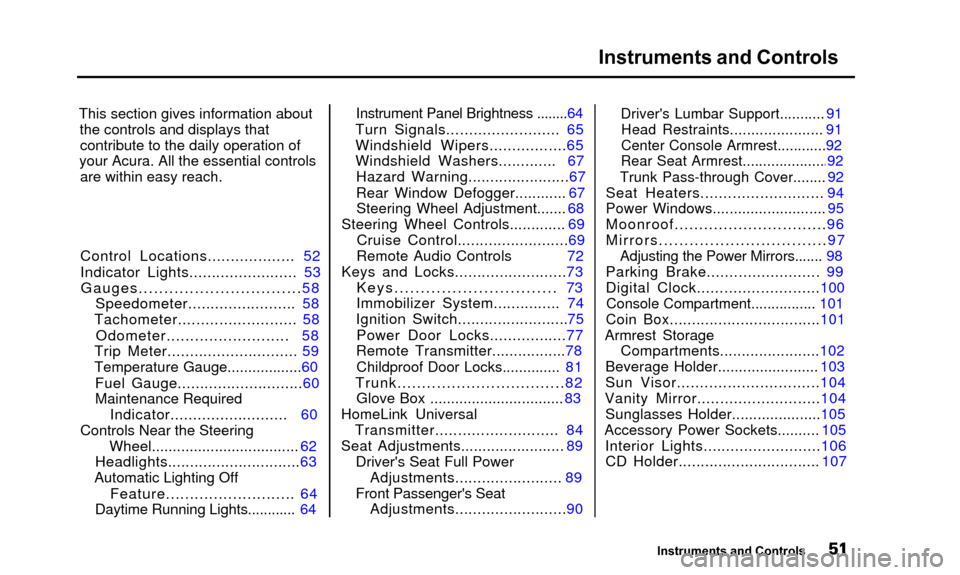
Instruments and Controls
This section gives information aboutthe controls and displays thatcontribute to the daily operation of
your Acura. All the essential controls are within easy reach.
Control Locations................... 52
Indicator Lights........................ 53
Gauges................................58
Speedometer........................ 58
Tachometer.......................... 58
Odometer.......................... 58
Trip Meter............................. 59
Temperature Gauge..................60
Fuel Gauge............................60
Maintenance Required Indicator.......................... 60
Controls Near the Steering
Wheel................................... 62
Headlights..............................63
Automatic Lighting Off
Feature........................... 64
Daytime Running Lights............ 64
Instrument Panel Brightness ........64
Turn Signals......................... 65
Windshield Wipers.................65
Windshield Washers............. 67 Hazard Warning....................... 67
Rear Window Defogger............ 67
Steering Wheel Adjustment....... 68
Steering Wheel Controls............. 69 Cruise Control.........................69
Remote Audio Controls 72
Keys and Locks.........................73
Keys............................... 73
Immobilizer System............... 74
Ignition Switch ......................... 75
Power Door Locks.................77
Remote Transmitter.................78
Childproof Door Locks.............. 81
Trunk.................................. 82
Glove Box ................................ 83
HomeLink Universal Transmitter........................... 84
Seat Adjustments........................ 89
Driver's Seat Full PowerAdjustments........................ 89
Front Passenger's Seat Adjustments.........................90
Driver's Lumbar Support........... 91Head Restraints...................... 91
Center Console Armrest............92
Rear Seat Armrest....................4 92
Trunk Pass-through Cover........ 92
Seat Heaters........................... 94
Power Windows........................... 95
Moonroof...............................96
Mirrors.................................97
Adjusting the Power Mirrors....... 98
Parking Brake......................... 99
Digital Clock...........................100
Console Compartment................ 101
Coin Box..................................101
Armrest Storage
Compartments.......................102
Beverage Holder........................ 103
Sun Visor...............................104
Vanity Mirror........................... 104
Sunglasses Holder.....................105
Accessory Power Sockets.......... 105
Interior Lights..........................106
CD Holder................................ 107
Instruments and Controls